Knowing how to soundproof a floor depends on two main factors. The first is the type of noise you’re blocking, and the second is the floor’s construction. Balancing these will give you the most effective solution for reducing unwanted sound transmission.
So, that’s exactly what I’ll cover in this article. We’ll look in detail at the types of noise and the most important soundproofing principles. Then we can cover the most effective soundproofing materials for different floor constructions.
Hopefully, by the end, you’ll be armed with the facts needed to make your room a calm and tranquil space!
The 2 Types of Noise: Impact and Airborne
Before digging down into the most effective solutions for soundproofing floors, we must understand the different types of noise pollution. We break them down into 2 broad categories: airborne and impact.
Airborne Noise
Airborne noise is the term used for sounds that move through the air. Sound waves are vibrations, so need some kind of medium to travel through. In this case, it’s air.
The sound wave leaves the source and travels through the air by making particles vibrate. They will likely then make contact with a structure (such as a wall) and transmit through it. In the process, they become significantly more muffled.
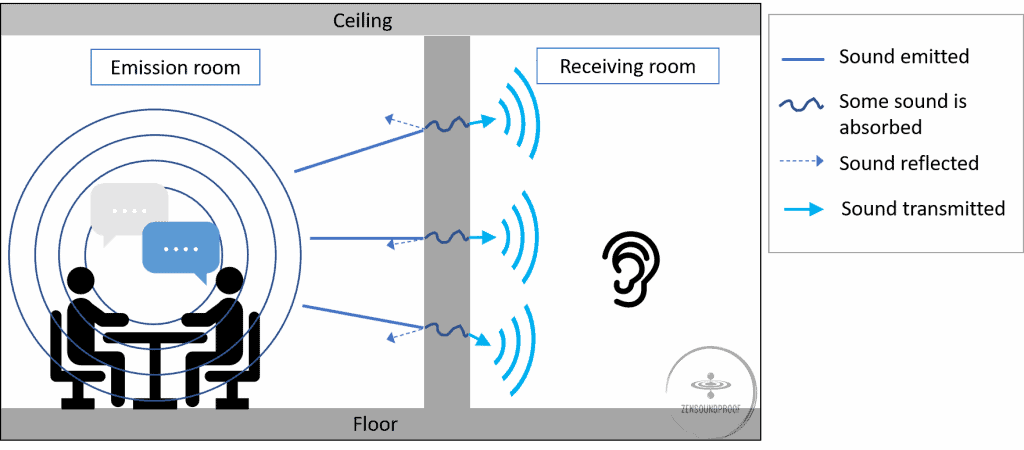
Common airborne sounds include:
- People talking
- TVs and music
- Dogs barking
Simply put, any noise that leaves its source and travels through the air before reaching your ears is airborne sound. As such, they’re a pretty common form of noise pollution.
Impact Noise
Impact noise is just as self-explanatory. It includes sounds created by an object making contact with a structure or surface. This process creates vibrations, which pass through the structure and out the other side, becoming sound waves.
Common examples include:
- Someone drilling into a wall
- Footfall noise
- Moving furniture
Impact vibrations are typically stronger than airborne vibrations making contact with a structure. That’s the main reason why you can still hear your neighbour drilling holes in his living room, while you can’t hear him talking.
As you can probably imagine, this means impact noises require different solutions to airborne sounds. To understand why, we must first look at the principles of soundproofing.

The Principles of Soundproofing
Soundproofing is a science. It means there are logical principles guiding our decisions based on what kind of noise we’re trying to reduce or block.
There are numerous principles, but we’ll only look at the 3 most important ones for this kind of soundproofing project. If you’d like to know about the one I’ve missed, check out my article discussing how they work in relation to walls.
Mass
Mass is one of the easiest principles to understand. Simply put, adding mass to a structure makes it more difficult to vibrate, and for sound to push through. However, mass is not equally effective across all the sound frequencies. It works better against middle to high frequencies. It does get a bit more technical than that, as we can look at limp and rigid mass.
Rigid mass would be something like drywall or bricks. The object has mass, but it’s stiff. It means its deformation is minimal. Some noise will bounce back and some noise frequencies will go through (mostly low frequencies). On the other hand, limp mass has much higher deformation. As such, a sound wave can’t ripple through the material as easily because a big part of its energy is dissipated by deformation. It’s especially effective against low frequency sounds.
Imagine throwing a ball at a bed sheet hanging on a washing line. On impact, the ball will drop to the floor. Now imagine throwing the same ball at a brick wall; it’ll bounce right back at you. This is the difference between limp and rigid mass.
Decoupling
Decoupling is arguably one of the most effective methods of soundproofing. It involves mechanically separating 2 sides of a structure. You can achieve that by adding a soft layer in the structure to break the soundwaves path.
In the illustration below, an underlay is added below the flooring. The latter is therefore isolated from the rest of the structure. The underlays is made of a softer material (foam, or cork for example) which prevents noise from spreading to the structure.
Building 2 sides of a wall on separate joists (example: staggered stud walls) or a suspended ceiling with resilient channels are other forms of decoupling.
Doing so puts an air cavity in the middle, which reduces the transmission of sound waves at mid to higher frequencies. The negative is that the cavity becomes a resonance chamber (generating low frequency noise). You can make up for this by filling the cavity with an absorptive material, such as fiberglass insulation.
Absorption
Absorption isn’t a massively important principle when discussing how to soundproof a floor. As stated above, we use it to fill empty cavities to reduce resonance. This principle is more relevant if you’re looking to soundproof a wall or a ceiling after decoupling.
Absorptive materials have open structures, which traps sound waves and prevents them from easily leaving again. In turn, their energy is converted into heat energy. These materials, when not installed in walls or ceilings, are used to deal with noise reverberation and echo.

Dampening
Finally, we have dampening. It basically involves reducing or stopping vibrations. By extension, it cuts down on sound transmission because there are fewer (or no) vibrations.
Imagine you flick a drinking glass and can hear it ring. Now imagine putting your hand on it; it stops ringing. This is essentially the principle of dampening.
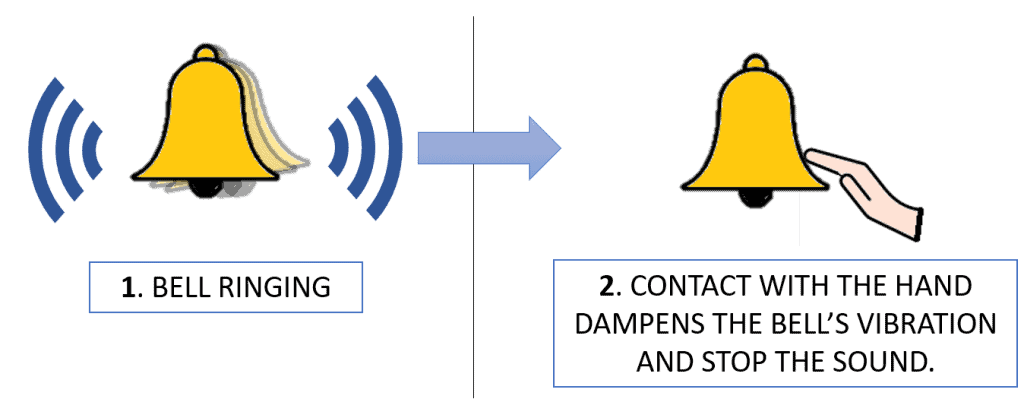
We can use various materials to dampen sound waves transmitting through a floor but, much like decoupling, they’re most effective at different frequencies.
Using These Principles for Impact and Airborne Noise
Before jumping into your soundproof floors project, you should decide what type of noise you’re trying to block. It’ll usually be airborne, as this is far more common, but many people will want to block impact noise, too. This is particularly true for those living in apartments or in houses with next-door neighbors.
Once you have a picture of the noise you’re trying to block, use these points below to get you going in the right direction. They’re what I expand on in my solutions.
Use mass for Airborne Noise
To block airborne noise, we need to build a thick and heavy barrier. Those are the two main characteristics we want to emphasize in your floor assembly. Good sound blocking materials are:
- OSB (Oriented Strand Board)
- MDF (Medium Density Fiberboard)
- Cement board
- Drywall
- Mass Loaded Vinyl (MLV)
The capacity of a material to block airborne noise is measured using STC ratings. If you’re curious about how STC is calculated, you can learn more about it here.
Decoupling Agents for Impact Noise and Airborne Noise
We can use different decoupling materials depending on whether we’re blocking impact or airborne sounds.
For impact noises, something like a floor underlay works well, and this also provides dampening. Decoupling agents are often made of soft compounds. Rubber, foam, fibers, and cork are resilient materials.
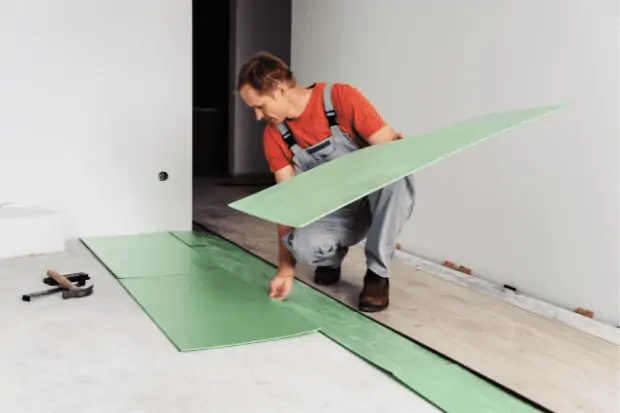
For airborne sounds, it’s most effective to mechanically separate the floor from the underlying structure. For this, resilient channels are one of the best options (if you’re not building the floor from scratch). However, installing resilient channels fit more into the category of soundproofing a ceiling, which I covered in more depth here.
4 Ways of Soundproofing New Floors
1) Add Acoustic Floor Underlayment
- For Impact noise
- For Airborne noise
If you’re in the process of building or laying a new floor, make sure you include acoustic floor underlayment. The type of floor underlayment you choose will depend on the noise you’re trying to block.
By now, you should have an idea of whether you’re working with airborne or impact sounds. If not, have a think about this before proceeding with a solution. Of course, you can add an acoustic underlayment for each type.
Resilient Underlay
For impact noise, you can add an acoustic floor underlayment made of resilient materials. The sound waves will travel from the floor to the underlayment, instead of spreading straight to your house structure.
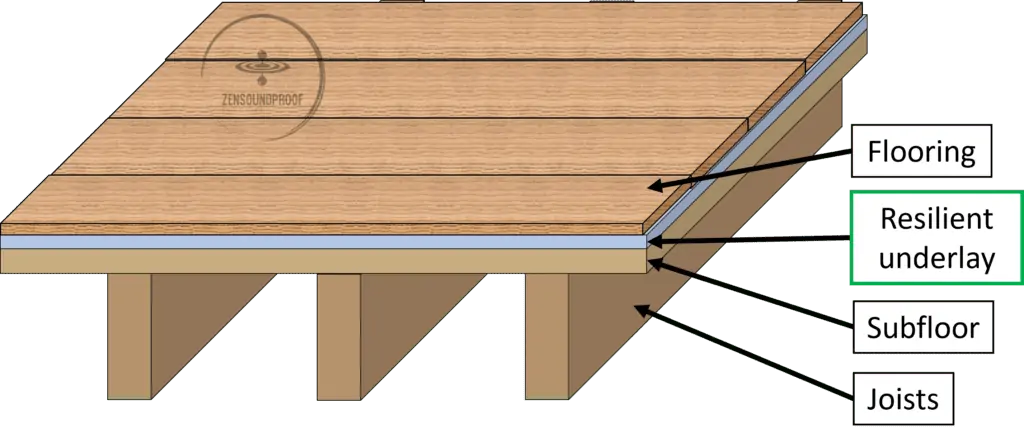
To clarify, a resilient material has the ability to absorb energy. For our purposes, this typically means soft and dense materials such as rubber, foam, fiber, and cork. The effectiveness of flooring underlayment to counter impact noise is measured with IIC ratings (Impact Insulation Class). The higher, the better.
Acoustic underlayment will absorb and reduce sound waves at mid and high frequencies. The nature of your flooring is also essential. To soundproof hardwood flooring, floor tiles, or laminate flooring require different types of underlay.
For a thorough guide on how to compare IIC ratings and pick the best soundproof underlays, check our article here.
Solid Underlay
The most effective underlayments for blocking airborne noises, like voices or TV sounds, are heavy. Soundproofing under hardwood floors (or any type of floor) by adding extra layers of mass is the way to go. You can see it as stacking a sound barrier to your floor. You can achieve this by integrating layers of heavy materials like:
- OSB (Oriented Strand Board)
- MDF (Medium Density Fiberboard)
- Cement board
- Drywall
- Mass Loaded Vinyl (MLV)
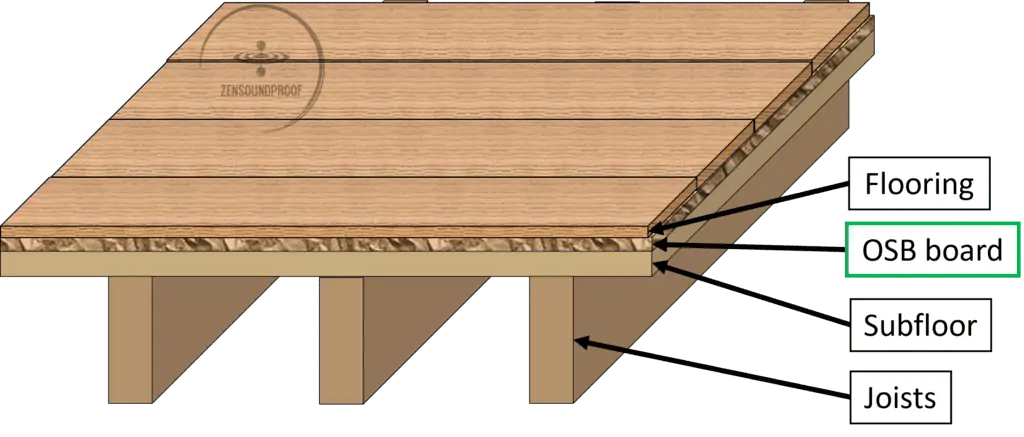
Note about MLV: Mass Loaded Vinyl is an excellent material if you’re looking for a thin and heavy material. However, it’s more expensive than its alternatives considering the weight achieved.
2) Green Glue
- For Airborne noise
Green Glue is a go-to dampening compound in soundproofing projects. The company makes 2 products: acoustic caulk and a dampening compound, so make sure you buy the right one.
It’s a viscoelastic material, which means it never sets completely hard. It dissipates sound waves between 2 layers of structure, reducing the level of transmission. The compound absorbs sound waves and converts them into heat energy. Green glue works well against low-frequency airborne noise.

However, Green Glue should never be used on its own, but rather as an add-on to existing soundproofing materials. Specifically, you must apply it between 2 solid layers of similar weight and thickness. For example, 2 OSB boards should do the trick.
The company has extensive test data on its website that explains how it works. Make sure you check it out for a better understanding of what other materials you should use. While most tests focus on walls, the logic is similar enough for floors.

For example, in a floor construction, you could sandwich the Green Glue between a layer of floor laminate and a layer of OSB, and include resilient acoustic underlayment below.
3) Resilient Channels
- For Impact noise
- For Airborne noise
Resilient channels are essentially long pieces of metal that you fix into clips. These clips have small rubber washers in them that dampen sound waves passing through the structure. You then fix the flooring materials into the resilient channels.

This creates what’s known in the industry as a floating floor, a term referring to a decoupled structure. Floating floors are quite effective at reducing sound transmission from impact and airborne noises.
As you can imagine, this is a pretty big soundproofing project, but it delivers decent results. You should always use decoupling alongside other materials, such as acoustic underlayment and dampening compound.
4) Joist Isolators
- For Impact noise
- For Airborne noise
Joist isolators are a fairly similar product, but are perhaps easier to install because they’re smaller. Typically, we’d use U-shaped rubber spacers, which sit over the joist and have the floor mounted on top. They’re made from plastic and help to isolate vibrational energy passing through the floor.
Alternatively, you can use noiseproofing joist tape. It’s typically made from PVC and does a similar job in terms of sound isolation.
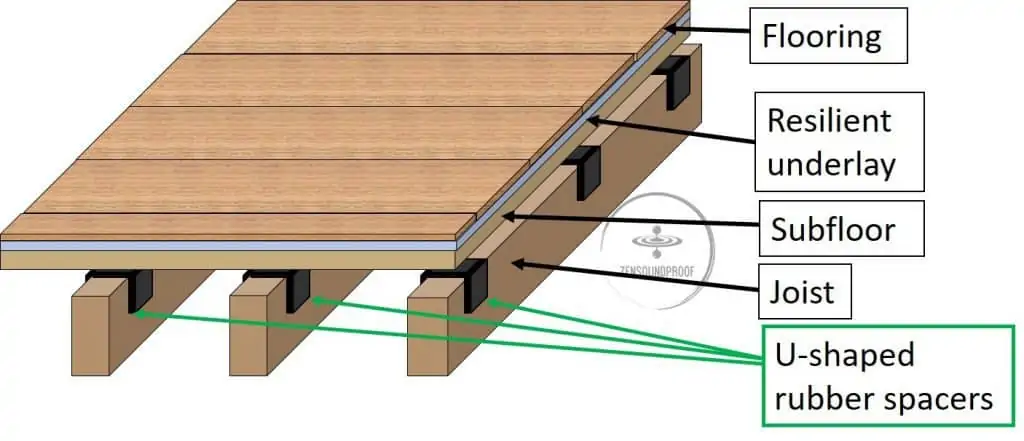
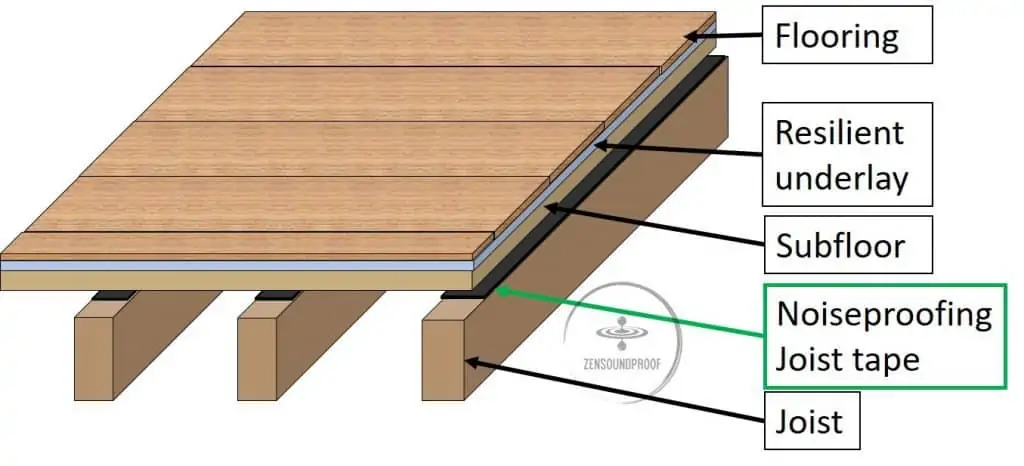
There is no need to decouple the floor from the wall around if you have a floating installation. Note that Acoustic sealant is a good addition if you want to fill the gaps between the wall and the floor.
Other means of decoupling exist for ceiling and wall structures. You can check out here about wall decoupling methods. Here, you can learn more about ceiling decoupling methods.
4 Ways of Soundproofing Existing Floors (in Apartments)
As you can imagine, your options to make a soundproof apartment floor (that’s already built) are slightly more limited. If you can’t rip up the existing floor (for example, if you live in an apartment), here are some solutions for reducing noise transmission.
1) Carpet or Rugs
- For Impact noise
- For Airborne noise
Carpet is a pretty decent option for reducing impact noise before it enters the building’s structure. Simply put, it adds a soft layer between the noise source and the floor, meaning the impact is cushioned as it happens.
Carpet will help with airborne sounds to an extent, too. This is because the structure of a carpet’s fibers will absorb and muffle sound waves reverberating around the room. However, don’t rely on carpet as a foolproof method for reducing echo and reverberation. For more information on solutions, check out my article on how to reduce echo in a room.
Of course, thicker carpets provide better dampening than thinner carpets. If you can, consider replacing the existing carpet with one that has a thick pile. This will be the best way to reduce impact noises in your room.
But if you already have a carpet and it’s too thin, you have a few options. The first is to add a rug on top of the carpet. While this might not be practical in every room, a thick rug will do the same job as a thick carpet. You could obviously use this solution on hardwood floors, too.
2) Carpet Padding
- For Impact noise
Another option is to use carpet padding. Carpet pads are exactly what you think: pads that go under a carpet or rug. In this case, you’d be putting it under a rug on top of the carpet.
Carpet padding will provide grip and add extra thickness to counter those impact sound waves. For example, if you want a thick model, RUGPADUSA is a popular pick. A more budget friendly option would be this non-slip rug pad by VEXEN.
Bear in mind that these options will only be as good as the product you buy. So, consider the advice given above regarding acoustic underlayment, as carpet pads do the same job. Look for resilient materials that are fairly thick and high quality.
3) Interlocking Floor Mats
- For Impact noise
A similar solution is to use floor mats (or tiles). These are basically the interlocking floor mats you might find in a gym, kid’s play area or even a workshop. You’ll find them in various materials and colors, but EVA foam is a popular choice. It fits into the resilient material bracket, making it ideal for our needs.
Rubber floor mats usually fit together in a puzzle-style pattern. Alternatively, if you have a smaller space, you could use something like a yoga mat. Interlocking floor tiles are ideal for spaces such as home gyms or kids’ rooms depending on the color and style you choose.
You have the choice of colors with this model. If you need more thickness options, this other variant might fit you better.

Of course, a rubber floor mat won’t be to everyone’s taste. But nothing is stopping you from hiding them under a rug, such as I suggest above. If it wasn’t already clear, rubber floor mats are best against impact noises, similar to the carpet pads above.
4) Build an Additional Flooring over the Existing One
- For Impact noise
- For Airborne noise
Sometimes removing existing flooring material can be a big source of trouble. I had this type of experience in my flat. The carpet floor in my bedroom was coming off with the cement base level filler. It was mainly due to the carpet glue being too strong and aging badly.
I later discovered that a perfectly viable solution is to build a new floor over the existing one. Despite involving the word “build”, it’s actually a relatively simple job (providing you know how to lay a floor!).
Not only can it give your room a completely new look, but it’s also the perfect excuse to include the other soundproofing materials you need to reduce transmission. Of course, make sure you have permission from your landlord or building owner (if applicable) because this still counts as a DIY project.
The rough steps are as follows:
1. Remove the skirting baseboards
You can do this with a crowbar or hammer. How rough you are depends on whether you want to reuse the baseboards or install new ones. Either way, it’s usually worth having them in the room.
2. Install a layer of acoustic underlayment
I’ve discussed this product in enough detail above, so I won’t bother repeating it. However, just make sure you choose the right one for the type of floor you’re installing.
If your existing flooring is carpet, you can just keep that instead. Carpet does a decent job of dampening impact noises, so there’s little point in adding more underlayment over it. Consider adding a vapor barrier to control moisture, too.
3. Install your new flooring
Follow the manufacturer’s instructions for this. Something like laminate flooring will be the easiest to lay over acoustic underlayment or carpet. However, you then have the issue of hard flooring. Whatever you choose, make sure it improves rather than worsens your sound transmission problem.
Consider using some acoustic caulk around the edges of the floor. It’ll seal the gap where the floor meets the wall and reduce sound leakage into the room below.
4. Install the baseboards
Again, this is fairly self-explanatory. You’ll have to glue (or nail) them in place once the floor is fitted, and you’re done.
Final Thoughts on How to Soundproof a Floor
Hopefully, you’ve now got enough information to start your floor soundproofing project. Of course, I haven’t covered all the nuances of materials and constructions, but this guide should be a good jumping off point.
I recommend spending some time deciding on your goals and researching products. Manufacturers will have recommendations about which products work where, and this advice can be invaluable if you’re unsure where to go.
Of course, if you have any questions, I’m more than happy to help. Reach out to me in the comments below and we can discuss it further. Thanks for reading!







1 thought on “8 Ways: How to Soundproof a Floor for Apartments, or House”
Hi Ludavic!
This was a great explainer. We are struggling in an apartment over a loud bar below us. There are speakers on their ceiling, so on the underside of our floors. The bar claims they’ve used sound proofing measures, but we do not believe them.
Is bass vibrations considered impact noise if it’s directly on the floor? We struggle most with the vibrations and thumping. What would be the best measure to combat this on our end? Would carpets and/or rubber flooring help in the reverse too or only on the ceiling side?
Thank you!